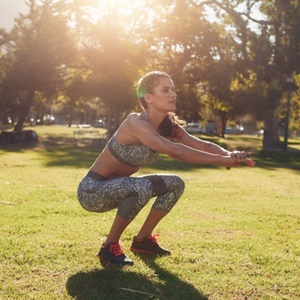
Many pros use the squat to assess a client’s body before a workout. “It reveals practically everything,” says personal training manager Kyle Dobbs.
“Everything” includes your physical history (traumas, chronic pains), current daily routine (how often you sit, stand, walk, stretch, run and exercise) and strengths and weaknesses (muscular imbalances). Drop into a basic body-weight squat and check your own form for these common concerns.
1. Knees collapse in
Once you’ve lowered into position, your knees cave in so they align closer to your big toes than the middle of your feet. It’s a condition called valgus. It can be both the cause and effect of knee pain and is sometimes linked to ligament sprains or tears.
The cause: Some experts blame tight hips – from too much sitting, running(without stretching) or both. But some research suggests that stiff ankles may also be responsible. Limited ankle dorsiflexion (a fancy term for how well you can point your foot up) causes your feet to turn in as you squat, which rotates your legs, knees included, inward.
The fix: Reduce sitting hours as much as possible and spend at least three minutes stretching your hips with lunges and pigeon pose or happy-baby pose when you wake up, after a workout and before bed. Strengthening hamstrings and glutes will also help lessen stress on your hips – try three sets of 20 glute bridges four days a week. To improve ankle mobility, trace lowercase Ts for a minute every day.
Read more: Why you need to stop ignoring this body part during your workouts
2. Asymmetrical legs
You put more weight on one side as you settle into your squat, so your body looks a bit off-balance. You may only notice by looking in a mirror.
The cause: You’ve probably suffered some type of aggravation or injury on the side you lean away from, whether recently (in this case, you’ll feel some discomfort) or in the past (you likely developed a muscular imbalance, where your healthier side became stronger than the other to pick up the slack). Pain or not, you’ll want to fix imbalances: your better side will only continue to get stronger until it can no longer overcompensate, which could result in injury to, sorry, either side.
The fix: See a physiotherapist to figure out what’s causing you to favour one side. When you have your diagnosis, the physio can help you treat it.
3. Lower-back rounds
As you approach the bottom of your squat, your tail bone tucks under, creating a curve in your spine. Experts have dubbed it “butt wink” (funny) and over time, it can lead to a disk herniation (not so funny).
The cause: Tight hip flexors prevent your pelvis from lowering into a deep squat, so your spine steps in to help tilt it backward. Another culprit: sucking in rather than bracing your abs, which throws your back into a flexed position.
The fix: Stretch your hip flexors at least twice a day. Stand and hold one knee, then the other, into your chest for one minute. To develop abdominal stability, practise bracing your abs (tightening them like someone is about to punch you) and breathingfrom your diaphragm (your belly will expand and contract) through plank variations, like forearm or side plank.
Read more: 4 minor tweaks that’ll give you major workout gains
4. Knees pass toes
At the bottom of your squat, your knees aren’t lining up with your toes but extending past them, so your body leans slightly forward. Your heels are actually lifting off the ground, shifting your centre of gravity forward. Not only are you missing the full butt-toning benefits of the squat, but you could also fall.
The cause: The issue usually traces back to poor glute activation. In other words, your quads initiate the sit-back movement instead of your glutes and hamstrings. You might also have tight calves and ankles – perhaps from daily jogs or that stiletto habit you just can’t kick – which prevent you from grounding your heels.
The fix: Train your glutes to switch on during exercise by doing deadlifts and donkey kicks and stretch your lower legs by bending alternate knees in downward dog.
5. Lower-back arches
As you deepen into your squat, your spine looks more like half of a U than a V – well beyond a natural curve in your back. The stress on your spine in this position (especially if you add weight) may also increase your risk of disk injuries.
The cause: Ugh, tight hips strike again! But this time it’s combined with tense lats, the muscles around the sides of your back. The two issues produce anterior pelvic tilt, in which your hips rotate forward, jutting out your belly and curving your spine.
The fix: At least twice a week, strengthen your core with planks and foam-roll your lats – lying on your side with a roller under your armpit, roll your body up and down.
This article was originally published on www.womenshealthsa.co.za
Image credit: iStock




 Publications
Publications
 Partners
Partners










